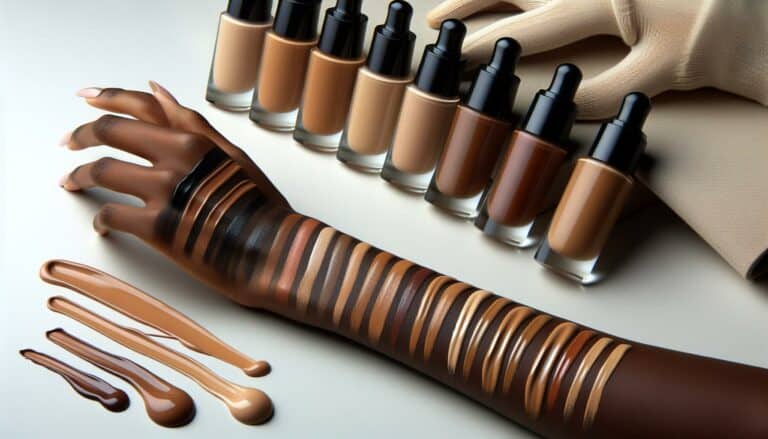Stop Foundation Separation: Tips for Flawless, Long-Lasting Makeup
What is foundation separation?
Foundation separation is a common concern that leaves many wondering about the integrity of their makeup routine. At its core, foundation separation refers to when your liquid or cream foundation doesn’t stay uniform on your skin. Instead, it splits or crumbles, creating a patchy and uneven appearance.
The results can be both frustrating and confusing, especially if you’ve applied the makeup in the same way you always have. But here’s the thing, it’s not just about application technique.
"Understanding foundation separation is key to solving it. It's not just a surface issue but a sign that the products may not be interacting well with your skin's natural oils or the layers beneath."
Below is a table showing common reasons behind foundation separation:
| Reason | Explanation |
|---|---|
| Product Incompatibility | Using products that don’t blend well together, like silicone-based primer with water-based foundation. |
| Skin Type Issues | Oily skin can cause makeup to break apart. |
| Improper Application | Not allowing layers to dry or absorb fully before applying the next. |
| Expired Products | Using makeup past its expiration date can lead to a less stable application. |
Product incompatibility and skin type issues are the most culprits behind this problem. Tackling foundation separation thus requires a keen eye on both the products you use and how they interact with your unique skin type. This understanding can be the first step towards a more flawless and lasting makeup application.
Common causes of foundation separation

When you’ve poured your time and energy into perfecting your makeup look, witnessing your foundation crease, crack, or separate can be nothing short of frustrating. But before you toss your favorite products in the bin, let’s explore some common causes behind this pesky problem.
Product Incompatibility is often at the top of the list. Like oil and water, some foundation formulas simply don’t mix well with certain primers or moisturizers. It’s essential to keep in mind the base of your products; silicone-based foundations, for instance, work best with silicone-based primers.
Another culprit might be the condition of your Skin Type. Oily, dry, or combination skin can react differently under layers of makeup. It’s not just about the foundation but understanding how your skin’s natural oils interact with your makeup.
Improper application techniques can also lead to foundation separation. Whether it’s applying too much product or not allowing layers to fully dry, these small missteps can have a big impact on your makeup’s longevity.
Lastly, Expired Products should not be overlooked. Like all cosmetics, foundations have a shelf life. Using them beyond this period can affect their consistency and performance.
Here’s a quick overview:
| Cause | Solution |
|---|---|
| Product Incompatibility | Match product bases (water, silicone, oil) |
| Skin Type | Use products suited for your skin type |
| Improper Application | Apply in thin layers and allow to dry between layers |
| Expired Products | Regularly check and replace outdated makeup |
By identifying and addressing these factors, you’re stepping closer to achieving that coveted, seamless foundation finish that lasts all day.
The role of skincare products
You might not realize it, but the skincare products you use play a crucial role in how well your foundation looks and lasts throughout the day. Let’s break down why this is and what you can do about it.
First off, it’s all about compatibility. If your skincare and foundation products are based on different formulas, they might not mesh well together. For instance, oil-based skincare products might not sit well with water-based foundations, leading to separation.
Here’s a quick guide on compatibility:
| Skincare Base | Foundation Base | Compatibility |
|---|---|---|
| Water | Water | High |
| Oil | Oil | High |
| Silicone | Silicone | High |
| Water | Oil | Low |
| Oil | Water | Low |
Another factor is the application of skincare products. Layering them properly and allowing each layer to absorb fully can make a huge difference. Hydration is key here. Well-hydrated skin provides a smooth canvas for your foundation, reducing the chances of separation.
Pro Tip: “Always allow your moisturizer and primer to fully absorb before applying foundation. This ensures a smoother application and longer-lasting wear.”
Product buildup can also be a culprit. Accumulation of skincare products without proper absorption or blending can create a barrier that foundation struggles to adhere to, causing it to separate or cake. Regular exfoliation is important to remove dead skin cells and excess products, allowing your skincare and foundation to work as intended.
Incorporating these practices into your beauty routine can lead to a noticeable improvement in your foundation’s appearance and longevity. Remember, the right balance and compatibility between your skincare and foundation are essential for that flawless look.
Finding the right foundation formula for your skin type
Choosing the right foundation formula for your skin type is crucial in avoiding foundation separation. It’s like picking a custom outfit; what fits you perfectly might not suit someone else. Here’s how to match your skin type with the ideal foundation.
If you’ve ever asked yourself, “Why does my foundation separate on my skin?” it could very well be due to picking a formula that’s not quite right for your type of skin. It’s not just about the shade; the formula matters too.
For oily skin, matte foundations are your best friend. They help control excess oil, keeping your look fresh without the shine. Dry skin types, on the other hand, should reach for hydrating foundations that offer a dewy finish. This adds a bit of moisture and avoids that cakey look.
Sensitive or acne-prone skin? Look for non-comedogenic labels which mean they won’t clog your pores.
Here’s a quick reference chart:
| Skin Type | Foundation Type |
|---|---|
| Oily | Matte |
| Dry | Hydrating/Dewy |
| Combination | Satin/Matte |
| Sensitive | Non-comedogenic |
| Normal | Any Type |
Remember, it’s not just about applying foundation; it’s about applying the right foundation for your skin.
“Knowing your skin type is the first step to flawless makeup.”
Understanding your skin’s needs helps in choosing products that enhance rather than detract. And remember, experimentation is key. Sometimes, you have to try a few formulas before finding the one that feels like it’s barely there.
Tips for preventing foundation separation
Preventing foundation separation starts with understanding your skin and the products you’re using. It’s not just about finding the right foundation; it’s also about the application technique and the complementary products in your routine.
Firstly, ensure your skincare products are fully absorbed before applying foundation. This might mean waiting a few minutes longer in your morning routine, but it’s worth it for a seamless finish.
Secondly, primer is your best friend. Choosing a primer that works well with your foundation formula can significantly reduce the chances of separation. If you’re using a water-based foundation, go for a water-based primer. For silicone-based foundations, use a silicone-based primer. This compatibility helps to create a smooth canvas for your foundation.
| Foundation Type | Primer Type |
|---|---|
| Water-based | Water-based |
| Silicone-based | Silicone-based |
Remember, less is more. Applying foundation in thin layers and building up Gradually can prevent overloading your skin and reduce separation. Use a damp beauty sponge or a foundation brush for an even application.
“The key to flawless makeup is not just in the products you use, but how you apply them.” – Beauty Expert
Finally, setting your foundation is crucial. Use a light touch of setting powder or spray to lock everything in place without adding weight. Look for products that complement your skin type for the best results. Dry skin might prefer a hydrating setting spray, while oily skin might benefit from a mattifying setting powder.
| Skin Type | Setting Product |
|---|---|
| Dry | Hydrating Spray |
| Oily | Mattifying Powder |
Using these tips, you can ensure your foundation stays put, looking fresh and flawless throughout the day.
Conclusion
When you’re tackling the frustration of foundation separation, remember it’s not just about the products you use but how you use them. There’s a combination of factors that could be at play, from the Type of Foundation you’re using to how well you’re preparing your Skin Prior to Application. Let’s break down some key elements that might help you better understand why this happens.
- Skin Type: Oily, dry, or combination? Each type requires different preparation and foundation formulas.
- Product Compatibility: Are your skincare and foundation products compatible? Mismatched formulas can lead to separation.
- Application Technique: How you apply your foundation can make a huge difference. Remember, less is often more.
Here’s a quick glance at what could be affecting your makeup’s longevity:
| Factor | Potential Issue |
|---|---|
| Skin Type | Not using the right type of foundation for your skin |
| Product Match | Skincare and foundation formula incompatibility |
| Application | Applying too much product or in the wrong manner |
Expert Tip: “Always allow your skincare products to fully absorb before applying foundation. This simple step can make a significant difference in preventing foundation separation.” – Makeup Artist, Jane Doe
Understanding these elements and adjusting your routine accordingly can be transformative. Employing a layering technique, choosing compatible products, and focusing on application methods tailored to your skin’s needs are pivotal in achieving that perfect, long-lasting foundation coverage.








